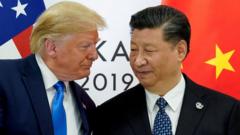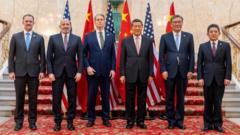South East Asia's economic landscape is being reshaped by former President Trump's tariffs aimed at China, forcing nations like Vietnam and Malaysia to rethink their trade strategies while balancing ties with both the US and China. Local businesses are struggling in this convoluted environment, which raises questions of protectionism and economic dependency.**
South East Asia Faces Dilemma Amid Trump's Tariff Policies**

South East Asia Faces Dilemma Amid Trump's Tariff Policies**
Countries in South East Asia encounter a critical challenge as they navigate the impacts of Trump's proposed tariffs on exports and reliance on both the US and China.**
South East Asia is at a crossroads as it confronts the repercussions of tariffs implemented by former US President Donald Trump against China. The tariffs, initially designed to protect American markets, have inadvertently disrupted economies in the region, where countries like Vietnam and Malaysia now face significant challenges.
Vietnamese entrepreneur Hao Le, head of SHDC Electronics, has been benefiting from a shift in trade dynamics but fears a potential 46% tariff on Vietnamese goods imposed by the US could cripple his business. His experience exemplifies a wave of homegrown enterprises striving to occupy the space left by restricted Chinese exports in US markets. While the tariffs opened opportunities for many, they also posed risks that could devastate local economies dependent on exports.
As nations like Vietnam ramp up their manufacturing capabilities, they now find themselves teetering between two economic giants: China, their largest trading partner, and the US, a crucial export market. This precarious position was highlighted by Malaysian Trade Minister Tengku Zafrul Aziz, who declared their intention to navigate a neutral path in the ongoing trade tensions.
Chinese President Xi Jinping's recent visits to South East Asia aimed to solidify economic ties with these nations, urging them to resist what he termed US "bullying." However, the interest in aligning with China complicates matters for South East Asian countries, as they also seek to maintain favorable relations with the US.
In the wake of Trump's tariffs, countries such as Thailand have swiftly worked to negotiate exemptions, while Indonesia and Malaysia are targeting the global electric vehicle supply chain and semiconductor industries, respectively. But many local businesses worry the halted tariffs have already caused irreversible harm, as competition from cheaper Chinese products continues to flood their markets.
Amid the dual pressures of preventing economic dependency on either giant and confronting the reality of increased Chinese imports, South East Asian authorities have begun exploring protective measures. For instance, Indonesia and Thailand have considered stricter tariffs on Chinese goods, reflecting a growing recognition of the need to shield local industries.
However, the ongoing strain on local economies is evident; numerous factories have closed, and thousands of workers have lost their jobs due to intense competition, leading to calls for government intervention. This wave of layoffs impacts public sentiment, demonstrating the social cost of larger geopolitical tensions.
The question now arises—how will these nations balance their strategies amidst unavoidable dependence on China for trade and the US for economic alliances? Some experts argue that a diversified policy, reducing reliance on either superpower, is crucial to foster stability across the region, advising against confrontation with either side.
As the evolving partnership between South East Asia and both the US and China unfolds, local businesses like SHDC Electronics are left to tread cautiously while hoping for a favorable outcome in a rapidly changing global marketplace. The future of South East Asia's economic ambitions hinges on their ability to adapt and navigate through the imposed challenges while protecting their local industries from external pressures.





















